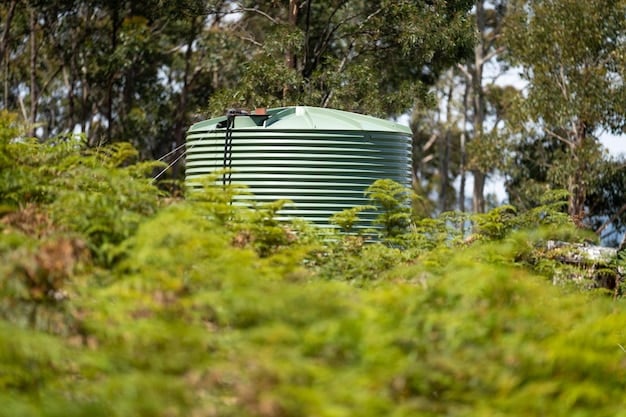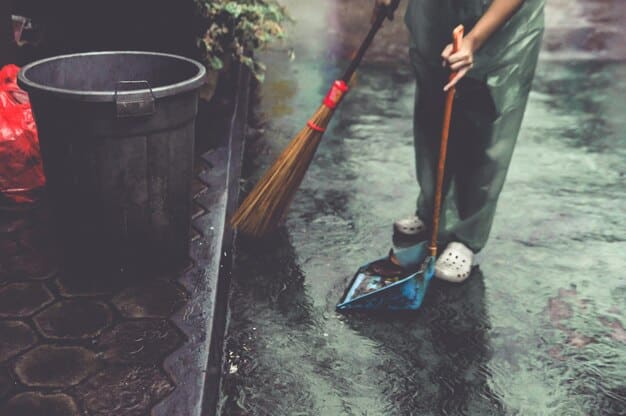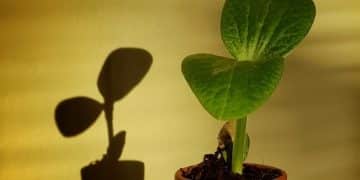Rainwater Harvesting: Save Water, Cut Bills by 10%+

Rainwater harvesting offers a sustainable solution to water consumption, enabling homeowners to collect precipitation for various non-potable uses, significantly reducing municipal water demand and potentially lowering water bills by 10% or more while mitigating environmental impact.
In an era where sustainability and resource conservation are paramount, exploring innovative solutions for daily living becomes essential. One such solution, gaining significant traction for its environmental and economic advantages, is rainwater harvesting. This age-old practice, modernized for contemporary homes, offers a compelling way to collect, store, and utilize this precious resource, promising not only a greener footprint but also tangible savings.
understanding rainwater harvesting: a sustainable approach
Rainwater harvesting, in its essence, is the practice of collecting and storing rainwater from surfaces like rooftops, rather than allowing it to run off. This collected water can then be used for a host of purposes, reducing reliance on municipal water supplies or groundwater. It’s an ancient technique, refined over centuries, now finding renewed relevance in our modern context of environmental consciousness and increasing water scarcity.
The concept is simple: instead of letting precious rainwater disappear into storm drains, where it often contributes to pollution and resource waste, it’s redirected into storage systems for later use. This not only conserves water but also helps mitigate urban runoff, reducing the strain on drainage infrastructure and preventing soil erosion.
The basic components of a system
A typical rainwater harvesting system, whether for a small residential garden or a larger commercial operation, generally comprises several key components working in concert:
- Catchment Area: This is the surface where rain falls, most commonly a rooftop. The material of the roof matters, as some materials may leach contaminants.
- Conveyance System: Gutters and downspouts typically form this system, directing water from the catchment area to the storage vessel. Proper slope and sizing are crucial for efficient flow.
- First-Flush Diverter: An essential component that diverts the first few minutes of rainfall, which often carries accumulated debris and pollutants from the roof, preventing it from entering the main storage.
- Filtration System: Various levels of filtration can be employed, from simple mesh screens to more advanced sediment filters, to remove physical impurities before the water enters storage.
- Storage Tank: Rain barrels, cisterns, or underground tanks are used to store the collected water. Their size depends on the intended use, rainfall patterns, and available space.
- Distribution System: This can be as simple as a spigot on a rain barrel for garden watering, or a more complex network of pumps and pipes for indoor non-potable uses.
Understanding these basic elements is the first step towards appreciating the versatility and benefits of a rainwater harvesting system. It’s a scalable solution, adaptable to various needs and budgets, providing a pathway to greater water independence and environmental stewardship.
By implementing these systems, households and businesses can actively participate in a sustainable water cycle, easing the burden on public water services and championing a more resilient future. The initial setup might require some investment, but the long-term ecological and financial returns make it a worthwhile endeavor for those committed to eco-friendly living.
economic advantages: collecting rain, cutting costs
One of the most compelling arguments for adopting rainwater harvesting is its significant economic benefit. In an age of rising utility costs and increasing demand for fresh water resources, any method that can reduce household expenses is worth considering. Rainwater harvesting fits this description perfectly, offering a practical way to lower your water bill and conserve financial resources.
When you collect rainwater, you diminish your reliance on municipal water suppliers. This direct reduction in consumption translates directly into savings. For many households, non-potable uses—such as landscape irrigation, toilet flushing, and even laundry—account for a substantial portion of their total water usage. By substituting municipal water with collected rainwater for these purposes, families can see a noticeable dip in their monthly expenditures.
quantifiable savings: reducing your water bill by 10% or more
The potential for savings is not just theoretical; it’s quite tangible. Studies and real-world examples consistently show that households implementing effective rainwater harvesting systems can reduce their water bills by 10% to 50%, depending on usage patterns, system size, and local water rates. The claim of reducing your water bill by 10% is often a conservative estimate, making rainwater harvesting an even more attractive proposition for the financially savvy homeowner.
Consider a typical household where outdoor watering for lawns and gardens consumes a significant amount of water during dry spells. Instead of drawing from the municipal supply, a rainwater harvesting system provides a free and readily available alternative. This completely eliminates the cost associated with that portion of water usage. Similarly, internal non-potable uses, like flushing toilets, can also be supplied by rainwater, further decreasing the metered water consumption.
Beyond the direct reduction in water bills, there are other financial incentives worth noting. In some regions, local governments or utility companies offer rebates, tax credits, or other subsidy programs to encourage the adoption of rainwater harvesting systems. These programs can significantly offset the initial installation costs, making the investment even more accessible and financially viable for many.
- Lowering Utility Bills: Direct reduction in metered water consumption translates into immediate savings.
- Reduced Peak Demand Charges: Some utility companies charge higher rates during peak usage times; rainwater allows for use outside these periods.
- Potential for Government Incentives: Rebates and tax credits can offset initial installation costs.
- Increased Property Value: An eco-friendly home with sustainable features can be more appealing to potential buyers.
Long-term maintenance costs for well-designed rainwater systems are typically low, adding to their economic appeal. Over time, the cumulative savings can easily outweigh the initial investment, making rainwater harvesting not just an environmental choice but a financially prudent one. This makes the system an economically sound decision for any homeowner looking to manage their household budget more effectively.
environmental stewardship: a commitment to sustainability
Beyond the clear financial incentives, the environmental benefits of rainwater harvesting are profound and far-reaching. This practice is a powerful tool in promoting ecological balance, conserving natural resources, and mitigating the adverse effects of human development on the environment. Embracing rainwater harvesting is a tangible way for individuals and communities to act as stewards of the planet, contributing to a more sustainable future.
One of the primary environmental advantages is the conservation of fresh water sources. As populations grow and climate patterns shift, many regions face increasing water scarcity. By utilizing rainwater for non-potable applications, we reduce the demand on critical freshwater ecosystems, allowing these vital resources to replenish naturally. This lessens the strain on rivers, lakes, and underground aquifers, preserving them for essential ecological functions and future generations.

mitigating storm water runoff
Another significant environmental benefit lies in managing stormwater runoff. In urban and suburban areas, impervious surfaces like roofs, roads, and parking lots prevent rainwater from soaking into the ground. Instead, it becomes runoff, collecting pollutants like oil, chemicals, pesticides, and sediment as it flows across these surfaces. This contaminated runoff then often overflows sewage systems and pollutes natural waterways, harming aquatic life and ecosystem health.
Rainwater harvesting systems intercept this runoff at its source, preventing it from contributing to pollution and erosion. By capturing and storing the water, these systems lessen the volume and velocity of stormwater entering drainage systems, thereby reducing the risk of localized flooding and the transport of pollutants into rivers and oceans. This directly supports healthier watersheds and cleaner aquatic environments.
Furthermore, the energy required to treat, pump, and deliver municipal water is substantial. Every gallon of municipal water consumed involves an energy footprint. By using harvested rainwater, which requires no such energy-intensive processing, households can indirectly reduce their carbon footprint. This contributes to combating climate change by decreasing energy consumption and, consequently, greenhouse gas emissions.
- Reduced Demand on Freshwater Sources: Protects rivers, lakes, and aquifers.
- Stormwater Management: Decreases urban runoff, flood risk, and water pollution.
- Energy Conservation: Lowers the energy needed for water treatment and delivery.
- Groundwater Recharge: When used for irrigation, rainwater can replenish local groundwater tables (depending on soil type and water usage).
- Chemical-Free Water: Rainwater is naturally soft and free of the chlorine and other chemicals often found in treated municipal water, which can be beneficial for gardens and certain household uses.
Adopting rainwater harvesting practices thus represents a comprehensive approach to environmental sustainability. It’s a step towards self-sufficiency in water resources, fostering a deeper connection with natural cycles and promoting responsible living. For those dedicated to “eco-friendly living,” incorporating rainwater harvesting is a powerful statement of commitment to the planet’s well-being.
designing your system: considerations for effective harvesting
Implementing a successful rainwater harvesting system requires careful consideration of several factors, ensuring optimal collection, storage, and utilization. It’s not a one-size-fits-all solution; what works best depends on your specific needs, location, budget, and local regulations. A well-designed system maximizes efficiency and longevity, providing a reliable source of water for years to come.
The first step in designing your system involves assessing your water needs and rainfall patterns. Understanding how much water you typically consume for target applications (e.g., gardening, toilet flushing) and how much rain your area receives annually will help determine the appropriate size of your collection surface and storage tank. Local historical precipitation data is readily available and invaluable for this planning phase.
choosing the right components and configuration
The choice of materials and components is critical for both the quality of the collected water and the system’s durability. Roofing materials, for instance, should ideally be non-toxic and structurally sound to avoid contaminating the water. Food-grade plastics or concrete are commonly used for storage tanks to prevent leaching of harmful substances into the water.
Consider the placement of your storage tanks. They should be located in a shaded area to minimize algae growth and evaporation, easily accessible for maintenance, and situated close to the points of use to reduce pumping requirements. Aesthetic integration with your home and landscape is also a factor for many homeowners.
Furthermore, local regulations and building codes must be researched. Some municipalities have specific rules regarding rainwater harvesting systems, including permits, overflow requirements, and cross-connection prevention (to ensure collected rainwater doesn’t mix with potable water lines). Adhering to these guidelines is essential for legal compliance and safety.
- Site Assessment: Evaluate your roof area, sunlight exposure, and available space for tanks.
- Water Demand vs. Supply: Calculate your average water usage for non-potable needs and compare it to historical rainfall data to size your system appropriately.
- Material Selection: Opt for non-toxic, durable materials for roofs, gutters, and tanks.
- Pre-Filtration: Install effective leaf screens and first-flush diverters to maintain water quality.
- Maintenance Access: Design the system for easy cleaning and inspection of gutters, filters, and tanks.
- Pump Selection: If pressure is needed (e.g., for indoor use), choose an energy-efficient pump sized for your flow requirements.
- Overflow Management: Plan for safe and efficient overflow routing to prevent flooding and erosion.
Finally, consider the level of filtration needed based on how you intend to use the water. For garden irrigation, a simple mesh screen might suffice. For indoor non-potable uses like toilet flushing, more robust filtration, possibly including UV sterilization, might be necessary to ensure safety and prevent clogging. A well-thought-out design ensures your rainwater harvesting system effectively meets your needs, reduces your water footprint, and becomes a valuable asset to your home.
maintenance and water quality: ensuring safe and effective use
While rainwater harvesting offers numerous benefits, its long-term effectiveness and the safety of the collected water depend heavily on consistent maintenance and proper water quality management. Neglecting these aspects can lead to contaminated water, system inefficiencies, and potential health risks. Regular checks and proactive measures ensure your system remains a reliable source of clean, usable water.
The most crucial aspect of maintenance involves keeping your collection surfaces and conveyance systems clean. Gutters should be regularly cleared of leaves, twigs, and other debris that can accumulate and impede water flow. Clogged gutters can lead to water overflowing, preventing it from reaching the storage tank and potentially causing damage to your home’s foundation or landscaping.

maintaining water purity for various uses
First-flush diverters, designed to redirect the initial dirty runoff, also require periodic inspection and cleaning to ensure they are functioning correctly. Similarly, any pre-filters or screens installed before the storage tank should be cleaned or replaced regularly. These components are your first line of defense against sediment and larger debris entering your stored water, which can otherwise compromise its quality and potentially clog downstream components like pumps or irrigation lines.
The storage tank itself needs attention. Depending on the design and usage, tanks may require occasional cleaning to remove accumulated sediment at the bottom. This helps prevent the growth of bacteria and algae, especially if the tank is not completely opaque or is exposed to sunlight. If water is stagnant for extended periods or if there’s any concern about microbiological contamination, testing services are available, and in some cases, further treatment like UV sterilization or chlorination might be considered, particularly for indoor uses.
For systems used for irrigation, understanding the pH balance of the collected rainwater can be beneficial, as extremely acidic or basic water could affect plant health, though rainwater is typically slightly acidic and generally well-suited for most plants. The key is regular monitoring and addressing issues promptly.
- Regular Gutter Cleaning: Prevents blockages and ensures clean water collection.
- First-Flush Diverter Maintenance: Check and clean to ensure proper removal of initial dirty runoff.
- Filter Inspection and Replacement: Regularly clean or change filters to maintain water quality and flow.
- Tank Cleaning: Periodically remove sediment from the bottom of storage tanks.
- System Leak Checks: Inspect pipes, connections, and tanks for leaks to prevent water loss and damage.
- Water Quality Testing: For specific uses (e.g., indoor non-potable uses), consider occasional testing for pathogens or chemical contaminants.
- Pump and Plumbing Check: Ensure all mechanical components are in good working order.
By committing to a regular maintenance schedule, homeowners can ensure their rainwater harvesting systems continue to provide clean, free water efficiently and safely. This proactive approach not only extends the lifespan of the system but also maximizes the environmental and economic benefits of utilizing this invaluable natural resource.
beyond the bill: broader impacts and future prospects of rainwater harvesting
While the immediate financial benefits and environmental wins of rainwater harvesting are significant, its broader impacts extend far beyond individual household savings. This practice contributes to community resilience, promotes water independence, and plays a role in shaping a more sustainable future in the face of evolving environmental challenges. Its potential to transform our relationship with water is immense.
On a community level, widespread adoption of rainwater harvesting can significantly reduce the load on public water infrastructure. Less demand for centralized treatment and distribution means lower operational costs for municipalities and can defer the need for costly infrastructure expansions. This translates into more stable water rates for all citizens and a more robust, reliable water supply system, especially during droughts or emergencies.
fostering water resilience in the face of climate change
In regions susceptible to drought, rainwater harvesting offers a critical buffer. When municipal water supplies are restricted, homes with harvesting systems can continue to meet their non-potable water needs, alleviating pressure on the strained public system. This self-sufficiency enhances community resilience, making populations less vulnerable to the unpredictable nature of climate change and its impact on water availability.
Furthermore, rainwater harvesting promotes a decentralized approach to water management. Instead of relying solely on large, centralized systems, it empowers individuals and communities to manage a portion of their water needs locally. This distributed model fosters innovation, encourages local resourcefulness, and can lead to more efficient and equitable water use practices across a region. It’s a move towards a more localized, adaptable, and sustainable water future.
The educational aspect is also invaluable. When homeowners invest in rainwater harvesting, they often become more aware of their water consumption patterns, the value of water, and the broader water cycle. This increased awareness can lead to more conscious water use habits overall, contributing to a collective shift towards greater water conservation, even for potable uses. It cultivates a sense of environmental responsibility and empowers citizens to be part of the solution.
- Community Resilience: Reduces vulnerability to droughts and water shortages for entire regions.
- Decentralized Water Management: Promotes local control and efficiency in water use.
- Reduced Infrastructure Strain: Lessens the burden on municipal water treatment and distribution systems.
- Educational Catalyst: Increases awareness about water conservation and sustainable practices.
- Support for Green Infrastructure: Integrates with broader urban planning for sustainable development.
- Biodiversity Support: Helps maintain healthy ecosystems by reducing reliance on natural freshwater sources.
As we look to the future, rainwater harvesting will likely play an increasingly prominent role in integrated water management strategies. From smart cities incorporating large-scale collection systems to individual homeowners making a conscious choice for sustainability, the benefits of harnessing the rain are multifaceted and critical for our collective well-being. It’s not just about collecting water; it’s about cultivating a thriving, resilient future for generations to come, truly embodying the spirit of “eco-friendly living.”
| Key Aspect | Brief Description |
|---|---|
| 💧 Water Savings | Collection for non-potable uses reduces municipal water demand. |
| 💰 Cost Reduction | Potential to lower water bills by 10% or significantly more. |
| 🌍 Environmental Impact | Conserves freshwater, reduces stormwater runoff, and saves energy. |
| 🔧 Maintenance Tips | Regular cleaning of gutters, filters, and tanks ensures system longevity. |
Frequently Asked Questions About Rainwater Harvesting
▼
Generally, collected rainwater is not safe for direct consumption without proper treatment. While it starts pure, it can pick up contaminants from roofs and storage systems. For potable use, it requires extensive filtration, purification, and regular testing to meet safety standards. It is best suited for non-potable uses like irrigation or toilet flushing.
▼
The savings depend on your municipal water rates, the size of your system, and how much water you use for non-potable purposes. Many homeowners report savings of 10% to 50% or more. Utilizing rainwater for outdoor irrigation, toilet flushing, and laundry can significantly reduce your reliance on metered water, leading to noticeable financial benefits.
▼
A basic system typically includes a catchment area (like a roof), a conveyance system (gutters and downspouts), a first-flush diverter to remove initial pollutants, a filter or screen, a storage tank (rain barrel or cistern), and a simple distribution system (spigot or pump). More complex systems may include advanced filtration and UV sterilization.
▼
Rainwater harvesting laws vary significantly by state and even by local municipality across the US. While many states encourage it, some have specific regulations or restrictions, particularly concerning water rights or potable use. It’s crucial to check local building codes and water regulations with your county or city planning department before installing a system.
▼
Maintenance frequency depends on local conditions and system design. Generally, gutters and first-flush diverters should be checked monthly, especially during rainy seasons. Filters need cleaning or replacement every few months. Storage tanks might need internal cleaning annually or every few years, depending on sediment accumulation. Regular checks ensure optimal water quality and system longevity.
conclusion
Rainwater harvesting represents a powerful confluence of environmental responsibility and economic prudence. By capturing and utilizing the rain that falls freely from the sky, homeowners can embark on a path towards greater water independence, significantly reduce their monthly utility expenditures, and actively contribute to the health of our planet. It’s a practice that moves beyond mere sustainability, fostering a deeper connection with our natural resources and building resilience in the face of evolving environmental challenges. As we champion “eco-friendly living,” embracing rainwater harvesting stands out as a tangible and impactful step towards a more secure and sustainable future for all.





